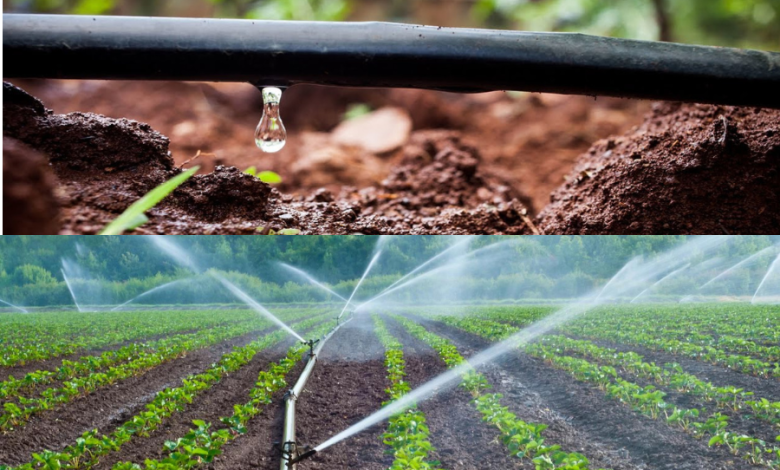Modern irrigation at the heart of Tanzania’s farming future

DODOMA: TANZANIA’S unwavering commitment to transforming its agricultural sector through modern irrigation technologies marks a critical shift toward sustainable development and climate resilience.
By integrating advanced systems such as centre pivots, drip irrigation and smart monitoring tools, the country is positioning itself to overcome the limitations of rain-fed farming and unlock its vast agricultural potential.
These innovations not only improve productivity and water-use efficiency but also pave the way for more consistent food production and economic stability. I an era where climate variability and population growth challenge food production, the country is taking significant strides to modernise its agricultural systems through the expansion of irrigation technologies.
Recently, government-led initiatives have been shifting this narrative, emphasising sustainable and technologically driven irrigation solutions to ensure year-round food production and economic resilience.
The spotlight on modern irrigation systems was recently intensified at the Nane Nane Agricultural Exhibition 2025 in Dodoma, where National Irrigation Commission (NIRC) introduced new state-of-the art irrigation technologies at the Mitambo Village pavilion.
The innovations include centre pivot irrigation systems, well-drilling machinery, reservoirs and various irrigation techniques such as drip systems. The aim is to educate farmers and stakeholders on modern irrigation practices as part of efforts to transform the agricultural sector through innovative technologies.
The Acting Director-General of NIRC and Director of Administration and Resource Management, Ms Maria Itembe said the technologies are new to the Commission but are widely used internationally to revolutionise irrigation farming.
“The Commission is participating in this year’s Nane Nane exhibition here at Nzuguni and we invite farmers and all agricultural stakeholders to visit our pavilion to learn and be inspired to adopt modern water resource management technologies for irrigation,” she said.
Ms Itembe stressed that irrigation is key to food security, improving household incomes and boosting the agricultural sector’s contribution to the national economy.
These technologies, once considered exclusive to largescale commercial farms, are now being adapted for use across Tanzania, including by smallholder farmers and public institutions.
With systems capable of irrigating up to five hectares within 24 hours and tools that precisely measure soil conditions and weather patterns, these advancements offer increased water-use efficiency and greater yields.
The technologies are already being installed in several irrigation project farms, in line with government directives to embrace modern technologies in agriculture to increase productivity and efficiency.
Prime Minister Kassim Majaliwa, in his keynote address at the exhibition stressed the strategic importance of irrigation in securing Tanzania’s agricultural future.
After inspecting the technologies on display and engaging with engineers at the NIRC, Mr Majaliwa commended the sector’s progress but also urged the Ministry of Agriculture to broaden its collaborations with both public institutions and the private sector.
“Extensive efforts have been made in irrigation. Now the Ministry, together with the National Irrigation Commission, must involve other sectors to expand irrigation services across the country using modern technologies,” he said.
He added that these systems should not be limited to agriculture alone, but also support initiatives like greening public sports grounds, especially in arid regions like Dodoma. This, he said, would reduce dependency on artificial turf and encourage natural, sustainable field maintenance.
Mr Majaliwa urged Permanent Secretaries, the Tanzania Prisons Service, the National Service (JKT) and private agricultural investors to be equipped with modern irrigation systems to secure the country’s food supply.
By advocating a coordinated national approach, Mr Majaliwa is calling for irrigation to be recognised as a national priority, central to food security, economic productivity and environmental sustainability.
The future plans of the government are to construct irrigation infrastructure that will increase the area under irrigation from 983,466.6 hectares in 2025 to 5,000,000 hectares by the year 2030.
In the past three years, the government’s investment to irrigation increased from 51.49bn/- in 2021/22 to a whopping 403.78bn/- in 2024/25.
The move is part of broader efforts to strengthen food security, increase crop yields and build resilience against climate change-induced droughts.
It is also part of the larger Agricultural Sector Development Programme (ASDP II), which prioritises irrigation infrastructure, water harvesting technologies and climate-smart farming.
The plan also emphasises stimulating industrial access to raw materials through the expansion of efficient, irrigation-driven agriculture, while simultaneously creating employment and raising income levels for farmers and broader communities.
The strategic rollout of modern irrigation technologies in country signals more than just a technological shift by reflecting a systemic transformation in how the country approaches agricultural development, climate adaptation and food security.
By prioritising irrigation in national policy and significantly scaling public investment, the government is addressing structural weaknesses that have long hindered agricultural productivity, particularly the overreliance on unpredictable rainfall.
ALSO READ: Govt prioritises irrigation to drive Vision 2050
The projected increase in irrigated land from under one million hectares in 2025 to five million by 2030 is not just ambitious, it is a calculated move to reduce vulnerability to climate-induced shocks while boosting the sector’s economic viability.
The integration of internationally recognised technologies such as centre pivot systems with smart sensors demonstrates a commitment to efficiency, precision and scalability.
These technologies align with broader trends in climatesmart agriculture, where data-driven decision-making, water conservation and soil health are central to long-term sustainability.





